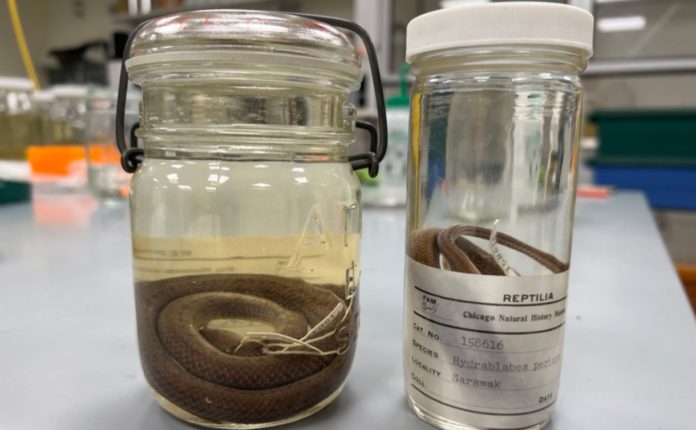There is a hidden bunker two stories underneath Chicago’s Field Museum. The Collections Resource Center, located in the building’s basement, is home to millions of biological specimens used by researchers from all over the world. Among these are numerous jars containing pickled fish, lizards, and snakes.
The combination of formalin and alcohol in the preservation process has allowed many of these specimens to remain almost unchanged for decades, if not centuries.
But, the preservation of tissues frequently destroys or at least makes it very challenging to obtain DNA for contemporary investigations, which is terrible news for researchers who examine the genetic links between creatures.
However, a new study published in Frontiers in Ecology and Evolution discloses novel methods for extracting and amplifying useable DNA from decades-old pickled specimens and applies them to a long-standing puzzle involving a little snake from Borneo.
Sara Ruane, assistant curator of herpetology at the Field Museum and the study’s senior author, says, “as a true crime aficionado, it reminds me of how people didn’t take DNA samples when a crime was committed in the 1960s, because nobody could have predicted that one day DNA samples would let you pinpoint who committed a crime.”
According to the author, “these older museum specimens are sometimes the only available examples of a species, but they weren’t preserved with DNA in mind— this paper is about how we can squeeze every bit of information possible out of them .”
The project originated from Justin Bernstein’s dissertation study while he was Ruane’s student at Rutgers University-Newark. According to Bernstein, the paper’s principal author, “my primary study is on a group of snakes, called homalopsids or mud snakes, that live in South and Southeast Asia, New Guinea, and Australia.”
This work is an attempt by Bernstein and Ruane to classify a single animal, a two-foot-long greenish-brown snake known as Hydrablabes periops (also known as the olive small-eyed snake). It is located on Borneo, a huge island east of the Malaysian mainland and northwest of Australia that encompasses portions of Malaysia and Indonesia as well as the entire republic of Brunei.
Scientists hypothesized that it belonged to one of two families based on its appearance. Its closest relatives and family could be found by looking at its DNA, but that was easier said than done. The majority of mud snake diversity and all Hydrablabes vouchers are from older specimens that underwent chemical treatment, which destroys DNA, claims Bernstein.
The “fixing” of an animal with formalin, a formaldehyde gas and water solution that makes its tissues rubbery and hard, is a step in the alcohol preservation process. Unfortunately, its DNA is also changed in the cells.
According to Ruane, “it does something called crosslinking, which binds up the DNA.” You must undo or attempt to force the DNA out of those crosslinks if you wish to examine its DNA.
Small liver tissue samples were to be taken from two of the few American specimens, both from the Field Museum’s collections, in order to study the olive small-eyed snake. One dates back to 1964, and the other was acquired on a 1993 collecting excursion by Tan Fui Lian, the wife of the Field’s then-curator Robert Inger.
Such ancient specimens required new laboratory procedures. Adding digestive enzymes that separate the tissue while leaving the DNA behind and heating a tissue sample to 130 °F for many hours are the typical methods for extracting DNA from it.
Ruane explains that in order to remove the DNA, the procedure needs to be altered to be hotter for a longer period of time and use more of these digesting enzymes. Despite the fact that these more rigorous preparation techniques had previously been successful for other snakes, the genetic study of the Borneo Hydrablabes snake specimen still had several gaps.
According to Bernstein, the chemicals employed to preserve the snakes cut their DNA into shorter fragments of code, making it difficult to compare them to longer, more complete genes from other species.
“The first software that I used made it hard to understand how much fragmented DNA there was across the study specimens, but switching to a different software that visualized the pieces of genetic code made it easier to see where there were problems,” adds the researcher.
And even smaller, more fragmented chunks of code might be incorporated into bigger, publicly available information to aid in the construction of an evolutionary tree.
For Bernstein, one of the most essential aspects of this paper was being open about the problems of using older specimens and the troubleshooting required to examine them.
“I wanted to show scientists that you can still do work with these specimens, it just requires a bit of finagling,” he adds.
“On a broader level, the study is really showing how to leverage the data you do obtain and how you can combine it with previously published datasets to investigate some really cool hypotheses.”
The Bornean snake at the center of the investigation is a member of the family Natricidae, which also includes distantly related species like North American garter snakes.
This may not seem important, but according to Ruane, “knowing that a particular species is part of a certain group can tell us a lot about biogeography and about how life on Earth has changed over time”.
The author adds that, ultimately, “this project underscores the importance of museum collections, because you never know what you’ll be able to learn from specimens in the future”.
Image Credit: Josh Mata, Field Museum
You were reading: New Approach Solves Long-standing Mystery Of A Pickled Snake
